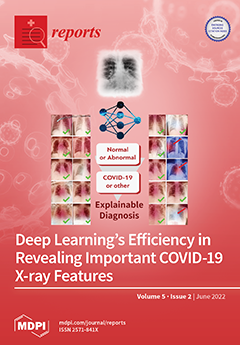Open AccessCase Report
A Challenging Case of Visceral Leishmaniasis
by
Antonio Giovanni Solimando, Giuseppe Coniglio, Vanessa Desantis, Gianfranco Lauletta, Davide Fiore Bavaro, Lucia Diella, Anna Cirulli, Giuseppe Iodice, Piero Santoro, Sebastiano Cicco, Giuseppe Ingravallo, Fabio Signorile, Roberto Ria, Monica Montagnani, Annalisa Saracino and Angelo Vacca
Cited by 3 | Viewed by 2274
Abstract
The term leishmaniasis includes multiple clinical syndromes: visceral, cutaneous, and mucosal leishmaniasis, resulting from an infection of macrophages throughout the reticuloendothelial system in the dermis and the naso-oropharyngeal mucosa, respectively. The clinical phenotype is mainly driven by the leishmania biologic characteristics and, ultimately,
[...] Read more.
The term leishmaniasis includes multiple clinical syndromes: visceral, cutaneous, and mucosal leishmaniasis, resulting from an infection of macrophages throughout the reticuloendothelial system in the dermis and the naso-oropharyngeal mucosa, respectively. The clinical phenotype is mainly driven by the leishmania biologic characteristics and, ultimately, also by the host immune status. The disease is endemic in focal areas in the tropics, subtropics, and southern Europe, transmitted by the bite of female phlebotomine sandflies. Sandflies regurgitate the parasite’s flagellated promastigote stage into the host’s skin; promastigotes bind to receptors on macrophages are phagocytized and transformed within phagolysosomes into non-flagellated amastigotes which replicate and infect additional macrophages. Amastigotes ingested by sandflies transform back into infective promastigotes. Depending on the host’s innate and acquired immune status, systemic and visceral leishmaniasis can be characterized by irregular fever, weight loss, enlargement of the spleen and liver, and anaemia. We present a 42 year-old man with long-lasting type 1 autoimmune hepatitis under immunosuppressive treatment. In January 2017, the patient started to experience low-grade unresponsiveness to empiric antibiotic therapy. The patient developed severe anemia and progressive multilineage cytopenia accompanied by increased levels of inflammatory markers. FDG-PET revealed increased glucose uptake in the liver, spleen, and the whole bone marrow. The subsequently performed bone marrow biopsy evidenced Leishmania amastigotes inside macrophages, confirmed by serological positivity to anti-Leishmania antibody. Immunosuppressive therapy was suspended and replaced by treatment with amphotericin B at 4 mg/kg/day from day 1 to day 5, followed by a single infusion on days 10, 17, 24, 31, and 38. The bone marrow smear after treatment still evidenced few Leishmania amastigotes; in consideration of the patient’s immunosuppression status, two further doses of amphotericin B on days 45 and 52 were employed, leading to infection resolution. In real-life, as exemplified in this case, administering two additional doses of amphotericin B (concerning the guidelines) offered an additional therapeutic opportunity for a patient under long-term immunosuppressive treatment.
Full article
►▼
Show Figures




